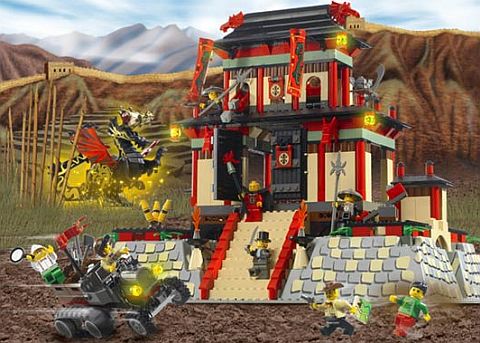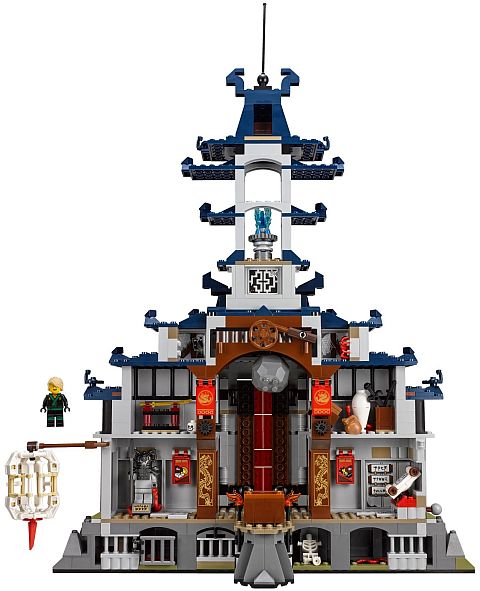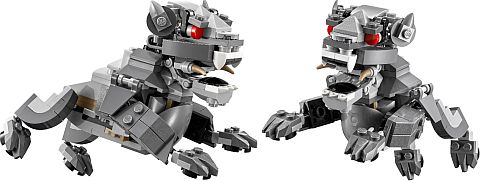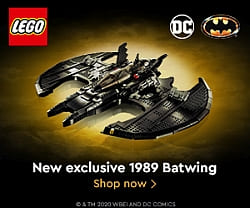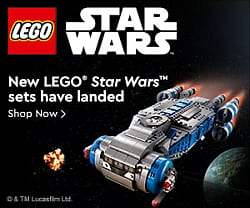There are a couple of new LEGO Minecraft sets we haven’t talked about yet; the #21135 LEGO Minecraft The Crafting Box 2.0, and the #21136 LEGO Minecraft The Ocean Monument. While all the LEGO Minecraft sets offer alternate instructions and suggestions for customization, I particularly like the #21116 LEGO Minecraft Crafting Box that was released back in 2014. The set is all about customization and boosting creativity, so I was very excited to see another LEGO Minecraft Crafting Box getting released. Below, we will look at both new sets in more detail. 🙂
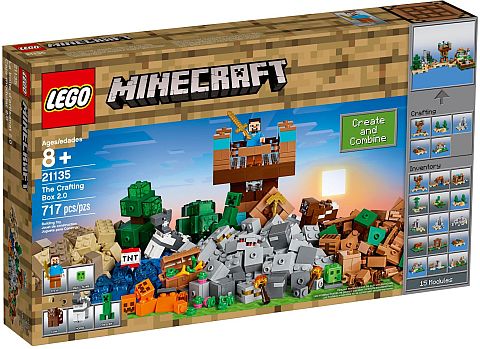
➡ #21135 LEGO MINECRAFT THE CRAFTING BOX 2.0: This set is all about free building! You get five bags, with a separate instruction booklet for each bag, and each instruction booklet includes three different models that you can build with the pieces. I also like how each of the bags has a distinct color-scheme. The first bag includes tan, nougat, brown and azure pieces, while the second bag is mostly tan, brown, and green (plus a still very rare Minecraft horse, and in a new color!). The third bag comes with shades of gray, the fourth bag is mostly brown with some nougat and green, and the fifth bag is a mix of earth colors, plus blue. It’s also great to see that the new Crafting Box has 200 pieces more than the previous one! If you like LEGO sets with lots of alternate instructions, prefer to free-build Minecraft style, or just want a big box of basic LEGO pieces in earth-tone colors, this kit is an excellent option.
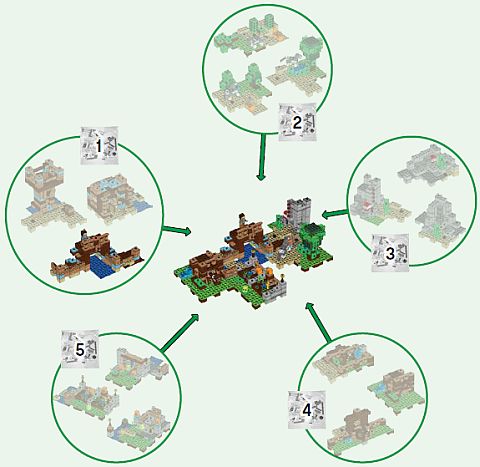
Here is the official description of the set: Create your own customized Minecraft landscapes in endless combinations with The Crafting Box 2.0. Build, rebuild, combine and enjoy hands-on Minecraft adventures featuring your favorite characters and objects. This easy-to-reconfigure, modular LEGO Minecraft set, designed for young fans of the highly successful sandbox video game, includes 5 brick bags, each containing one set of bricks with 3 alternative model configurations. Also includes a Steve minifigure plus horse, cow, slime and Creeper figures. Set your imagination free—rebuild the set for more LEGO Minecraft creations! 717 pieces. Price: $59.99 – BUY HERE
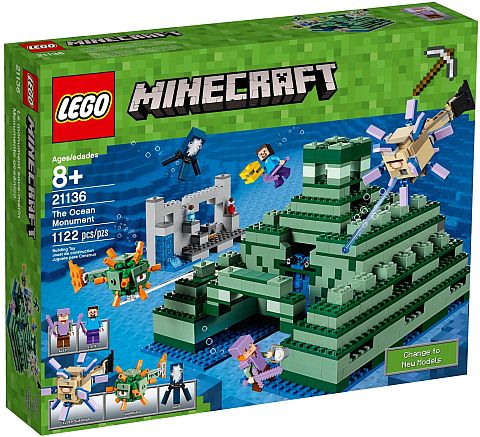 ➡ #21136 LEGO MINECRAFT THE OCEAN MONUMENT: I have to say that this is probably one of the weakest sets I have seen in the LEGO Minecraft collection as far as design. It looks boring, dull, and way to small for what it supposed to represent. It also doesn’t have a whole lot of play-features, and the ones it does, are not very interesting. However, the set has one redeeming quality; it’s a goldmine for sand-green and dark-green pieces! To give you an idea, in sand-green you get 26 1×1 bricks, 55 1×2 bricks, 26 1×4 bricks, 61 1×6 bricks and 54 2×2 bricks, and 32 2×2 jumper-plates (plus some other sand-green pieces in smaller quantities). In dark-green you get 16 1×1 bricks, 15 1×2 bricks, 51 1×2 plates, 17 2×2 tiles, 30 2×3 plates, 20 1×4 plates, 12 2×4 plates, 21 2×2 bricks, 16 1×6 plates, 2 large 6×6 panels, 38 2×8 plates, and 15 6×6 plates (plus some other dark-green pieces in smaller quantities). That’s a lot of two of the most desirable green-shades in one set! And there are other colors included as well; mostly grays, blues and black. You may or may not like this set for how it looks, but is definitely a respectable source of rare colors in large quantities.
➡ #21136 LEGO MINECRAFT THE OCEAN MONUMENT: I have to say that this is probably one of the weakest sets I have seen in the LEGO Minecraft collection as far as design. It looks boring, dull, and way to small for what it supposed to represent. It also doesn’t have a whole lot of play-features, and the ones it does, are not very interesting. However, the set has one redeeming quality; it’s a goldmine for sand-green and dark-green pieces! To give you an idea, in sand-green you get 26 1×1 bricks, 55 1×2 bricks, 26 1×4 bricks, 61 1×6 bricks and 54 2×2 bricks, and 32 2×2 jumper-plates (plus some other sand-green pieces in smaller quantities). In dark-green you get 16 1×1 bricks, 15 1×2 bricks, 51 1×2 plates, 17 2×2 tiles, 30 2×3 plates, 20 1×4 plates, 12 2×4 plates, 21 2×2 bricks, 16 1×6 plates, 2 large 6×6 panels, 38 2×8 plates, and 15 6×6 plates (plus some other dark-green pieces in smaller quantities). That’s a lot of two of the most desirable green-shades in one set! And there are other colors included as well; mostly grays, blues and black. You may or may not like this set for how it looks, but is definitely a respectable source of rare colors in large quantities.
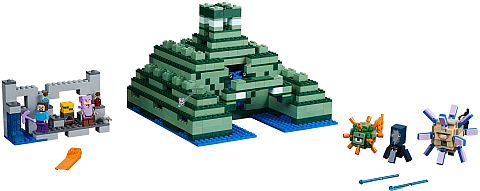
Here is the official description of the set: Head for the depths of the Minecraft sea to discover the Ocean Monument. Battle the elder guardian with spring-loaded shooter, activate the dry sponge function to enter the monument and locate the lever to open the treasure chamber full of golden blocks. Enjoy hands-on Minecraft adventures featuring your favorite characters and objects with this easy-to-reconfigure LEGO Minecraft set—designed for young fans of the highly successful sandbox video game. Includes Steve and Alex minifigures, plus squid, guardian and elder guardian figures. Measures over 5” (15cm) high, 9” (24cm) wide and 9” (24cm) deep. 1,122 pieces. Price: $119.99 – BUY HERE
From the two sets, I would definitely recommend the #21135 LEGO Minecraft The Crafting Box 2.0. It has everything going for it; lots of creativity, nice colors, endless building opportunities, and a great price. Unless you really like the look of the set, I would only recommend the #21136 LEGO Minecraft The Ocean Monument if you need a lot of sand-green and dark-green pieces. In the video-player above, JANGBRiCKS will show you both sets in more detail to help you decide if you would like to get them. Also, don’t forget about the massive #21137 LEGO Minecraft The Mountain Cave, which we talked about recently (see links at the end of this post). You can find the new sets under the LEGO Minecraft section of the Online LEGO Shop.

What do you think? How do you like these two new LEGO Minecraft sets? Do you have either of them already? Or are you planning to get them? Which is your favorite LEGO Minecraft set so far? Feel free to share your thoughts and own review in the comment section below! 😉
And you might also like to check out the following related posts:



